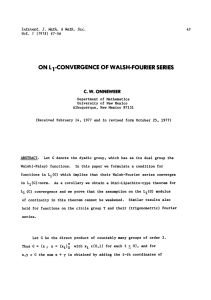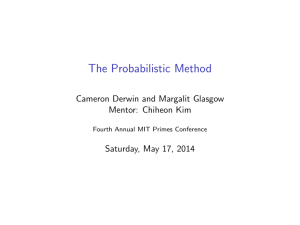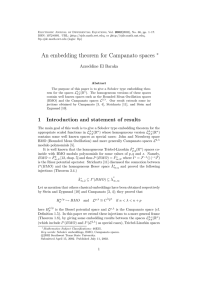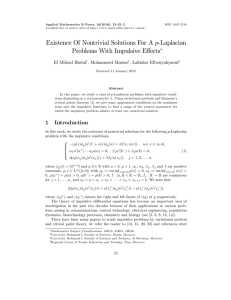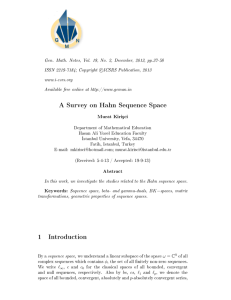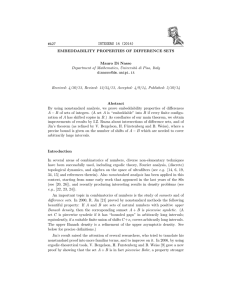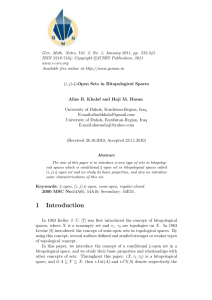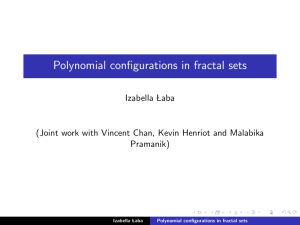A NOTE ON SELF-EXTREMAL SETS IN L SPACES (
advertisement
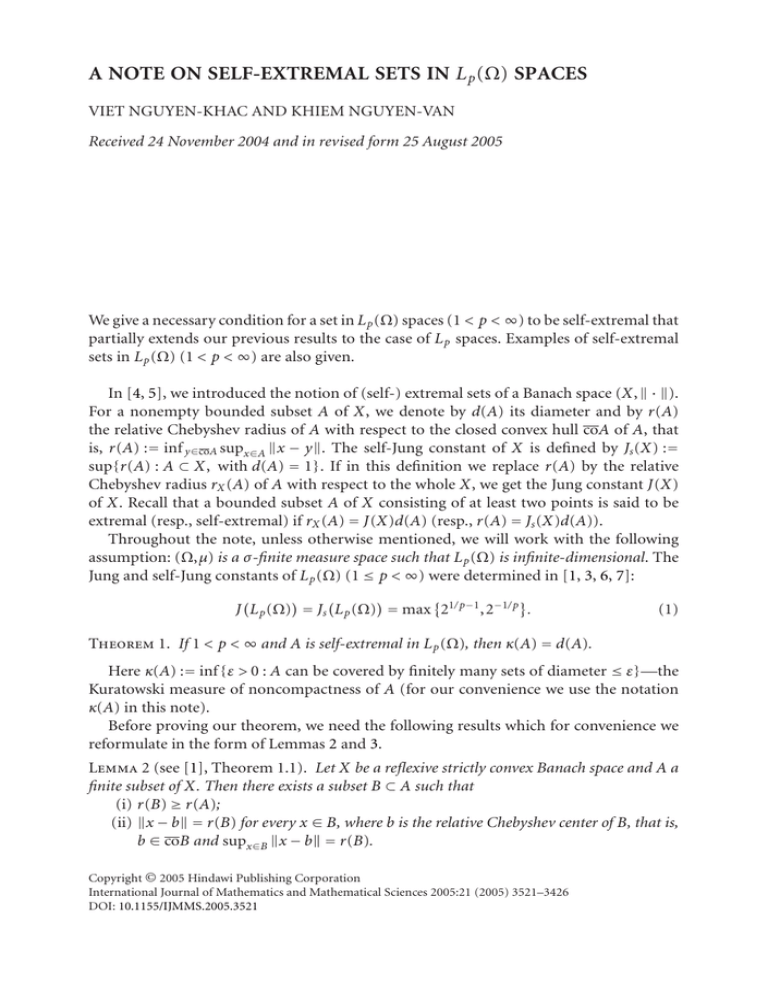
A NOTE ON SELF-EXTREMAL SETS IN L p (Ω) SPACES
VIET NGUYEN-KHAC AND KHIEM NGUYEN-VAN
Received 24 November 2004 and in revised form 25 August 2005
We give a necessary condition for a set in L p (Ω) spaces (1 < p < ∞) to be self-extremal that
partially extends our previous results to the case of L p spaces. Examples of self-extremal
sets in L p (Ω) (1 < p < ∞) are also given.
In [4, 5], we introduced the notion of (self-) extremal sets of a Banach space (X, · ).
For a nonempty bounded subset A of X, we denote by d(A) its diameter and by r(A)
the relative Chebyshev radius of A with respect to the closed convex hull coA of A, that
is, r(A) := inf y∈coA supx∈A x − y . The self-Jung constant of X is defined by Js (X) :=
sup{r(A) : A ⊂ X, with d(A) = 1}. If in this definition we replace r(A) by the relative
Chebyshev radius rX (A) of A with respect to the whole X, we get the Jung constant J(X)
of X. Recall that a bounded subset A of X consisting of at least two points is said to be
extremal (resp., self-extremal) if rX (A) = J(X)d(A) (resp., r(A) = Js (X)d(A)).
Throughout the note, unless otherwise mentioned, we will work with the following
assumption: (Ω,µ) is a σ-finite measure space such that L p (Ω) is infinite-dimensional. The
Jung and self-Jung constants of L p (Ω) (1 ≤ p < ∞) were determined in [1, 3, 6, 7]:
J L p (Ω) = Js L p (Ω) = max 21/ p−1 ,2−1/ p .
(1)
Theorem 1. If 1 < p < ∞ and A is self-extremal in L p (Ω), then κ(A) = d(A).
Here κ(A) := inf {ε > 0 : A can be covered by finitely many sets of diameter ≤ ε}—the
Kuratowski measure of noncompactness of A (for our convenience we use the notation
κ(A) in this note).
Before proving our theorem, we need the following results which for convenience we
reformulate in the form of Lemmas 2 and 3.
Lemma 2 (see [1], Theorem 1.1). Let X be a reflexive strictly convex Banach space and A a
finite subset of X. Then there exists a subset B ⊂ A such that
(i) r(B) ≥ r(A);
(ii) x − b = r(B) for every x ∈ B, where b is the relative Chebyshev center of B, that is,
b ∈ coB and supx∈B x − b = r(B).
Copyright © 2005 Hindawi Publishing Corporation
International Journal of Mathematics and Mathematical Sciences 2005:21 (2005) 3521–3426
DOI: 10.1155/IJMMS.2005.3521
3522
A note on self-extremal sets in L p (Ω) spaces
Lemma 3 (see [8], Theorem 15.1). Let (Ω,µ) be a σ-finite measure space,
1 < p < ∞,
x1 ,...,xn vectors in L p (Ω), and t1 ,...,tn nonnegative numbers such that ni=1 ti = 1. The
following inequality holds:
α
n n
n
α
≤
x
−
t
x
ti t j xi − x j ,
2 ti i
j
j
i =1
j =1
(2)
i, j =1
where
p
α = p−1
p
if 1 < p < 2,
(3)
if p ≥ 2.
Proof of Theorem 1. Since r(A) and d(A) remain the same with replacing A by coA, we
may assume that A is closed convex and r(A) = 1. For each integer n ≥ 2, we have
B x,1 −
x ∈A
1
∩ A = ∅,
n
(4)
where B(x,r) denotes the closed ball centered at x with radius r which is weakly compact
since L p (Ω) is reflexive. Hence there exist xqn−1 +1 ,xqn−1 +2 ,...,xqn in A (with convention
q1 = 0) such that
qn
1
B xi ,1 −
∩ A = ∅.
n
i=qn−1 +1
(5)
Set An := {xqn−1 +1 ,xqn−1 +2 ,...,xqn }. By Lemma 2, there exists a subset Bn = { ysn−1 +1 ,
ysn−1 +2 ,..., ysn } of An satisfying properties (i)-(ii) of the lemma. Let us denote the relative Chebyshev center of Bn by bn , and let rn := r(Bn ). By what we said above, we have
}. Since Bn is a
rn > 1 − 1/n and yi − bn = rn for every i ∈ In := {sn−1 + 1,sn−1 + 2,...,s
n
finite
set, there exist non-negative numbers tsn−1 +1 ,tsn−1 +2 ,...,tsn with i∈In ti = 1 such that
bn = i∈In ti yi . Applying Lemma 3, one gets
2rnα
α
α
=2
ti y−
tj yj
≤
ti t j yi − y j ,
i
i∈In
j ∈In
(6)
i, j ∈In
where α is as in (3).
Setting B∞ := { ysn−1 +1 , ysn−1 +2 ,..., ysn }∞
n=2 , we claim that κ(B∞ )=d(A). Evidently κ(B∞ ) ≤
d(A) by definition. If κ(A∞ )<d(A), so there exist ε0 ∈ (0,d(A)) satisfying κ(B∞ ) ≤ d(A) −
ε0 , and subsets D1 ,D2 ,... ,Dm of L p (Ω) with d(Di ) ≤ d(A) − ε0 for every i = 1,2,...,m
V. Nguyen-Khac and K. Nguyen-Van 3523
such that B∞ ⊂ m
i=1 Di . Then one can find at least one set among D1 ,D2 ,...,Dm , say D1 ,
with the property that there are infinitely many n satisfying
ti ≥
i ∈J n
1
,
m
(7)
where
Jn := i ∈ In : yi ∈ D1 .
(8)
From (1), it follows that (d(A))α = (1/Js (L p (Ω)))α = 2. In view of (6), we have, for all
n satisfying (7),
2 · rnα ≤
α
ti t j yi − y j i, j ∈In
≤ d(A) − ε0
≤ 2−
α
·
ti t j + d(A)
α
· 1−
i, j ∈Jn
d(A)
α
ti t j
(9)
i, j ∈Jn
α 1
− d(A) − ε0
· 2.
m
On the other hand, obviously 1 − 1/n < rn ≤ 1, therefore limn→∞ rn = 1. We get a contradiction with (9) since there are infinitely many n satisfying (7).
One concludes that κ(B∞ ) = d(A), and hence κ(A) = d(A).
The proof of Theorem 1 is complete.
Observe that no relatively compact set A in L p (Ω) (1 < p < ∞) is self-extremal by
Theorem 1. Hence we obtain an immediate extension of Gulevich’s result for L p (Ω)
spaces.
Corollary 4 (cf. [2]). Suppose that √1 < p < ∞ and that A is a relatively compact set in
L p (Ω) with d(A) > 0. Then r(A) < (1/ α 2)d(A), where α is as in (3).
The following theorem gives a necessary condition for a set in L p (Ω) (1 < p < ∞) to be
self-extremal.
Theorem 5. Under the assumptions of Theorem 1, for every ε ∈ (0,d(A)), every positive
integer m, there exists an m-simplex ∆(ε,m) with vertices in A such that each edge of ∆(ε,m)
has length not less than d(A) − ε.
Proof. We will assume A is closed convex and r(A) = 1. From the proof of Theorem 1, we
derived a sequence { ysn−1 +1 , ysn−1 +2 ,..., ysn }∞
n=2 in A and a sequence of positive numbers
{tsn−1 +1 ,tsn1 +2 ,... ,tsn }∞
(with
convention
s
1 = 0) such that
n =2
2 · rnα ≤
i, j ∈In
α
ti t j yi − y j ,
ti = 1,
i∈In
where rn ∈ (1 − 1/n,1], α is as in (3), and In := {sn−1 + 1,sn−1 + 2,...,sn }.
(10)
3524
A note on self-extremal sets in L p (Ω) spaces
We denote
α
ti yi − y j ,
Tn j :=
i∈In
Sn := j ∈ In : Tn j ≥ 2 · rnα · 1 − 1 − rnα
α
1
Sn (y j ) := i ∈ In : yi − y j ≥ 2 · 1 − √4
n
Sn y j := yi : i ∈ Sn y j ,
λn :=
ti = 1 −
i∈In \Sn
,
,
j ∈ Sn ,
(11)
j ∈ Sn ,
ti .
i ∈S n
One can proceed furthermore as follows. We have
2rnα ≤
=
i, j ∈In
tj
j ∈S n
≤2
α
ti t j yi − y j j ∈S n
α
α
ti yi − y j +
tj
ti yi − y j i∈In
j ∈In \Sn
t j + 2rnα 1 − 1 − rnα
i∈In
tj
(12)
j ∈In \Sn
= 2 − 2λn 1 − rnα + rnα 1 − rnα
≤ 2 − 2λn 1 − rnα .
Hence λn ≤ 1 − rnα → 0, as n → ∞. Thus limn→∞ (
On the other hand,
2rnα
≤
i, j ∈In
i∈Sn ti ) = limn→∞ (1 − λn ) = 1.
α
2
ti t j yi − y j ≤ 2 1 −
ti
≤ 2 1 − ti2
(13)
i∈In
for every i ∈ In . Therefore ti ≤ 1 − rnα → 0 as n → ∞. One concludes that the cardinality
|Sn | of Sn tends to ∞ as n → ∞. In a similar manner (cf. [5, the proof of Theorem 3.4]), for
every ε ∈ (0,d(A)) and a given positive integer m, we choose n sufficiently large satisfying
Sn > m,
α
1
≥ d(A) − ε
2 1 − √4
n
2αm
√
< 1,
4
n
(14)
such that for every 1 ≤ k ≤ m and every choice of i1 ,i2 ,...,ik ∈ Sn , we have
k
ν =1
Sn yiν = ∅.
(15)
V. Nguyen-Khac and K. Nguyen-Van 3525
With m and n as above and a fixed j ∈ Sn , setting z1 := y j , we take consecutively z2 ∈
m
k=1 Sn (zk ). One sees that
Sn (z1 ),z3 ∈ Sn (z1 ) ∩ Sn (z2 ),...,zm+1 ∈
zi − z j α ≥ 2 1 − √1 ≥ d(A) − ε α
4
(16)
n
for all i = j in {1,2,...,m + 1}, with n sufficiently large. We obtain an m-simplex formed
by z1 ,z2 ,...,zm+1 , whose edges have length not less than d(A) − ε, as claimed.
The proof of Theorem 5 is complete.
Remark 6. (i) Since for L p (Ω) spaces Js = J, the extremal sets in L p (Ω) are also self-extremal. Thus we obtain a similar result for extremal sets in L p (Ω) via Theorem 5 above.
(ii) In particular, Ω = N, µ(A) := card(A), A ⊂ N leads to the p space case [5, Theorem
3.4].
Example 7. (i) Let p ≥ 2, consider a sequence {Ωn }∞
i=1 consisting of measurable subsets
of Ω such that
0 < µ Ωi < ∞ ,
Ωi ∩ Ω j = ∅ ∀i = j;
i = 1,2,... ;
∞
Ωi = Ω.
(17)
i =1
Let χΩi denote the characteristic function of Ωi , and set
∞
A := fi
i =1 ,
χΩi
fi := 1/ p .
µ Ωi
(18)
One can check easily that r(A) = 1, d(A) = 21/ p , hence A is a self-extremal set in L p (Ω).
∞
(ii) In the case 1 < p < 2, we set B := {ri }∞
i=0 , where {ri }i=0 is the sequence of Rademacher functions in L p [0,1]. If r ∈ co{r0 ,r1 ,...,rn } and k ≥ n + 1, then it is easy to see that
d(B) = 21−1/ p and
r − rk :=
p
1
0
r − rk p dµ
1/ p
1
≥
r
− rk rk dµ = 1,
0
(19)
hence r(B) = 1. Thus B is a self-extremal set in L p [0,1] with 1 < p < 2. This is in contrast
to the p case [5], where we conjectured that there are no (self)-extremal sets in p spaces
with 1 < p < 2.
Acknowledgment
The authors would like to thank the referees for several improvements and suggestions.
References
[1]
[2]
[3]
T. Domı́nguez Benavides, Normal structure coefficients of L p (Ω), Proc. Roy. Soc. Edinburgh
Sect. A 117 (1991), no. 3-4, 299–303.
N. M. Gulevich, The radius of a compact set in Hilbert space, Zap. Nauchn. Sem. Leningrad.
Otdel. Mat. Inst. Steklov. (LOMI) 167 (1988), Issled. Topol. 6, 157–158, 192 (Russian).
V. I. Ivanov and S. A. Pichugov, Jung constants in np -spaces, Mat. Zametki 48 (1990), no. 4,
37–47, 158 (Russian).
3526
[4]
[5]
[6]
[7]
[8]
A note on self-extremal sets in L p (Ω) spaces
V. Nguyen-Khac and K. Nguyen-Van, A characterization of extremal sets in Hilbert spaces, to
appear in FPM, http://arxiv.org/abs/math.MG/0203190.
, A geometric characterization of extremal sets in p spaces, to appear in JMAA,
http://arxiv.org/abs/math.MG/0207304.
S. A. Pichugov, The Jung constant of the space L p , Mat. Zametki 43 (1988), no. 5, 604–614, 701
(Russian).
, Jung’s relative constant of the space L p , Ukrain. Mat. Zh. 42 (1990), no. 1, 122–125
(Russian).
J. H. Wells and L. R. Williams, Embeddings and Extensions in Analysis, Ergebnisse der Mathematik und ihrer Grenzgebiete, vol. 84, Springer, New York, 1975.
Viet Nguyen-Khac: Institute of Mathematics, Vietnamese Academy of Science and Technology, 18
Hoang Quoc Viet Road, 10307 Hanoi, Vietnam
E-mail address: nkviet@math.ac.vn
Khiem Nguyen-Van: Department of Mathematics & Informatics, Hanoi University of Education,
Cau Giay District, Hanoi, Vietnam
E-mail address: nguyenvankhiem77@yahoo.com




